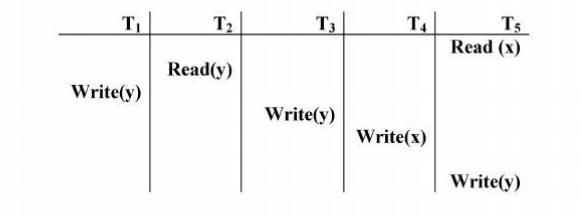If we use the Timestamp Ordering for concurrency control in the following scheduling:

My TA says $T_2,T_3,T_5$ is Run and $T_4,T_5$ is Rollback. I think it's false. Is there any expert who could help us?
If we use the Timestamp Ordering for concurrency control in the following scheduling:

My TA says $T_2,T_3,T_5$ is Run and $T_4,T_5$ is Rollback. I think it's false. Is there any expert who could help us?
Timestamp Ordering ensures serializability by serializing transactions in order of their timestamps.
The transaction that starts earlier is assigned smaller timestamp than a transaction started later. Assuming the given schedule shows each transaction's start. $T_{5}$ will have smallest timestamp.
So to ensure serializability the given schedule must be conflict serializable. In other words it must be conflict equivalent to a serial schedule(It is a schedule in which transactions are aligned in such a way that one transaction is executed first. When the first transaction completes its cycle, then the next transaction is executed) whose first transaction is $T_{5}$ because of smallest timestamp.
Because $Write(y)$ of $T_{5}$ conflicts with $Write(y)$ of $T_{3}$, $T_{5}$ is rolled back. Now considering $T_{1}$ , $T_{2}$, $T_{3}$ , $T_{4}$, their execution is already serial with respect to each other , the order being $T_{2}$ followed by $T_{1}$, followed by $T_{3}$, followed by $T_{4}$.
Hence only transaction $T_{5}$ is rolled back.
I know its a little too late, but here's my take:
All the read and writes by t1,t2,t3,t4 are sucessfully run, since there are just 1 instructions until that point. And assuming the systems assigns the timestamp just before each transaction's first instruction.
The last write(y) instruction by t5 is rejected, since the TS(T5) < W-TStamp and R-TStamp. Hence its restarted with a new time stamp.